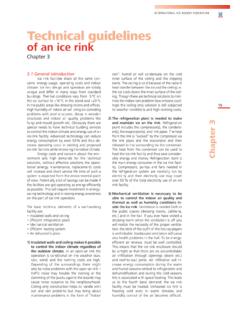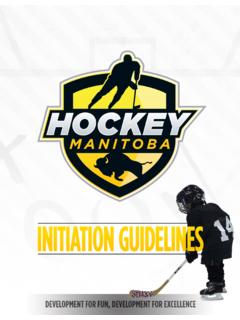Transcription of Podiatric Management in Ice Skating - AAPSM
1 NOVEMBER/DECEMBER 2003 PODIATRY article is the second in a seven-part sports podiatry series written bymembers of the American Academy ofPodiatric Sports Medicine. This sport-specific series is intended as a practical how-to primer to familiarize you withthe specific needs of patients who partici-pate in these sports, and the types of in-juries and treatment challenges you relikely to Skating in all its various formshas shown increased popularityworld wide. Olympic speed skatingchampions are coming from areas ofwarm climate and ice hockey teamsare starting up in almost every popu-lated geographical location. A closecousin to ice Skating is in-line skat-ing, which is a similar biomechanicalactivity and is another commonrecreational and fitness increasing popularity of skatingmakes it likely that all Podiatric prac-titioners will benefit from a funda-mental understanding of the man-agement of this athletic population,regardless of practice location.
2 Ice Skating involves three disci-plines: figure Skating , speed skatingand power Skating . It is power skat-ing that defines the unique skatingpatterns and mechanics of locomo-tion seen in ice hockey . The princi-ples of Podiatric biomechanics canbe applied to all of these skatingdisciplines, as many of the mechan-ics of foot position and balance aresimilar. For the purposes of this ar-ticle, however, I will focus on thebiomechanics of power R. Neil Humble, on page 50 Podiatric Management in Ice SkatingUnderstanding the biomechanics of this sport can help you better treat PODIATRYSPORTS PODIATRYBoth walking andskating are biphasicmovement patterns thatconsist of periods ofsingle and may arise, it is first helpful tocompare power Skating with themore commonly understoodbiomechanics of walking.
3 Bothwalking and Skating are biphasicmovement pat-terns that consistof periods of sin-gle and double-limb support. Bycomparison, it isthe support phaseof walking thatbecomes the skat-ing glide. One as-pect of skatingthat makes itunique in the sup-port phase is thatthe friction on theperformance surface is much lessthan that seen in most walking activ-ities. As a result there are decreasedposterior linearshear forces withtouchdown due todecreased frictionand decreased ante-rior linear shearforces in the latemidstance topropulsion low frictionsurface will neces-sarily impart a needto abduct the footby external hip ro-tation at center ofgravity thereforedoes not progress ina linear sinusoidalpath over the footas seen in walking,but rather theskater and his/herBiomechanics Power Skating in hockey in-volves Skating forward, backwardand with multiple directionalchanges as the game evolves.
4 It isthis ever-changing movement pat-tern that makes this activity diffi-cult to study from a biomechanicalstandpoint. It is forward accelera-tion and striding, however, that arethe most consistent and studied as-pects of power Skating . The podi-atric assistance in foot and lowerextremity balance on top of a nar-row balance point, the skate blade,will allow a practitioner to assist inboth improved performance andoveruse injury patterns. In order to better understandthe biomechanics of power skatingand the clinical injury perspectivescenter of gravity move in an oppositedirection to the weight bearing skate. The acceleration in power skat-ing is divided into two uniquestride patterns, the first threestrides and thefourth stride,known as thetypical skate first stridepattern usuallyinvolves the firstthree strides.
5 Itlasts approxi-mately sec-onds, involvescontinual posi-tive accelerationand has a negligi-ble or non-exis-tent glide is during thisstride pattern that the skater oftenappears to be running on second stride pattern oftenbegins on the fourth stride and isconsidered the typical skate stride pattern consists of peri-ods of positive and negative accel-eration and involves three starts with a glide during singlelimb support which imparts nega-tive continues withpropulsion during single limb sup-port which is accomplished by ex-ternal rotation of the thigh and theinitial extension movements of thehip and stride patternconcludes with propulsion duringdouble limb support. During thisphase the second limb acts as a bal-ance point to complete propulsionthrough full knee extension, hyper-extension of hip and plantar flex-ion of the on page Management NOVEMBER/DECEMBER 2003 Figure 1: Ice hockey , power most common footand lower extremityinjury patterns seen inice hockey are acutetraumatic #112 Clinical Injury Perspective Without a doubt the most com-mon foot and lower extremity injurypatterns seen in ice hockey are acutetraumatic events.
6 However, for thepurposes of this article we will focuson the more common presentingproblems in an office setting. Thereis, first, the common dermatologicconditions seen in this patient popu-lation. Second, there are the intrinsicfoot-to-boot injuries that can be pre-cipitated from the nature of theunique footwear, and last, there arethe specific biomechanically-pro-duced clinical injury patterns thatmay arise from overuse. A general understanding of skateanatomy and fit is necessary for a fullunderstanding of the impact of com-mon Podiatric pathologies, as well asfor an understanding of the biome-chanically-produced overuse injuriesseen in the Skating population. Thereis first the skate boot that is rigid forprotection and on page Management NOVEMBER/DECEMBER 2003 Figure 4: Skate AnatomyCircle #5boot itself.
7 The attachment of theblade housing to the boot can be apoint of biomechanical input. Thishousing can be moved medial tolateral, or anterior to posterior onthe boot. Its standard position isto hold the blades centrally underthe heel to continue forwardunder the second metatarsal headand further forward through thesecond digit. The blade housingcan also act as an attachment siteSewn skates generally fit one toone and a half sizes smaller thanone s regular shoe size. Skates needto fit snugly and toes should feather the toe cap. All bootshave a heel raise that may be fromfive degrees to nine degrees butcan vary from one manufacturer toanother. Next is the blade housingthat is riveted or screwed onto thefor heel lifts and wedges as theyare sandwiched between the hous-ing and boot.
8 Lastly is the narrowblade, which can also be adjustedfor biomechanical effect. It is rock-ered front to back and is hollowground on the bottom surface tocreate a medial and lateral edge orbite angle. The blade acts as a bal-ance point and as little as one inchis all that normally contacts theice surface. As mentioned above, skates needto fit snugly, and as such manyskaters wear their skates withoutsocks for a better feel. This prac-tice should be discouraged due tothe dermatological consequencesfrom both friction and hygiene. Blis-ters, corns, callouses, tinea pedis,onychomycosis, and verrucae arecommon in this patient of general Podiatric principlesalong with a thin, well-fitting per-formance sock with both hy-drophilic and hydrophobic proper-ties will decrease friction within theboot and improve hygiene.
9 If thinenough, it will still allow the feel needed for performance. The specificity of the footwearand its need for a performance fitcan also cause friction and pressureinjuries at the interface betweencommon structural foot deformitiesand the boot. Common podiatricpathologies such as hammertoesand bunions are a painful dilemmain this footwear and are treated inthe usual fashion. Haglund s defor-mity, however, is an especially dif-ficult problem for skaters. Other than traditional podiatrictreatments one may alleviate theskate counter pressure with internalor external heel lifts, accommoda-Ice on page Management NOVEMBER/DECEMBER 2003 Ice adhesive felt padding withinthe skates, or expansion of the heelcounter by a local skate shop. Awell-posted custom foot orthoticcan also decrease the movement ofthis prominence within the tight fit of skates can also in-crease the incidence of Morton sneuroma and dorsal superficialcompression neuropathies.
10 Proper boot structure, alongwith the necessary biomechanics ofskating, can decrease the frequencyof complaints from certain patholo-gies. Hallux limitus, Achilles ten-donopathy and plantar fasciitis areall less commonly a problem dur-ing Skating activities. Biomechanically-producedoveruse foot and ankle clinical in-jury patterns can clearly be identi-fied in ice Skating . The narrowblade or balance point creates needfor strenuous eccentric muscle con-trol and proprioceptive skills to as-sist in balance over this small bal-ance point. As a result, general footfatigue from strain of the small in-trinsic muscles of the foot are com-mon. As well as the intrinsic mus-cle strains, there are the extrinsictendonopathies that can occur inthe posterior tibial tendon and theperoneal tendons and muscles as areaction to the need for balance.




